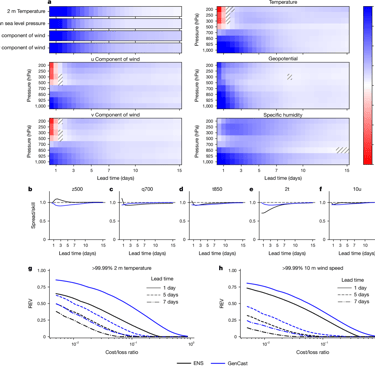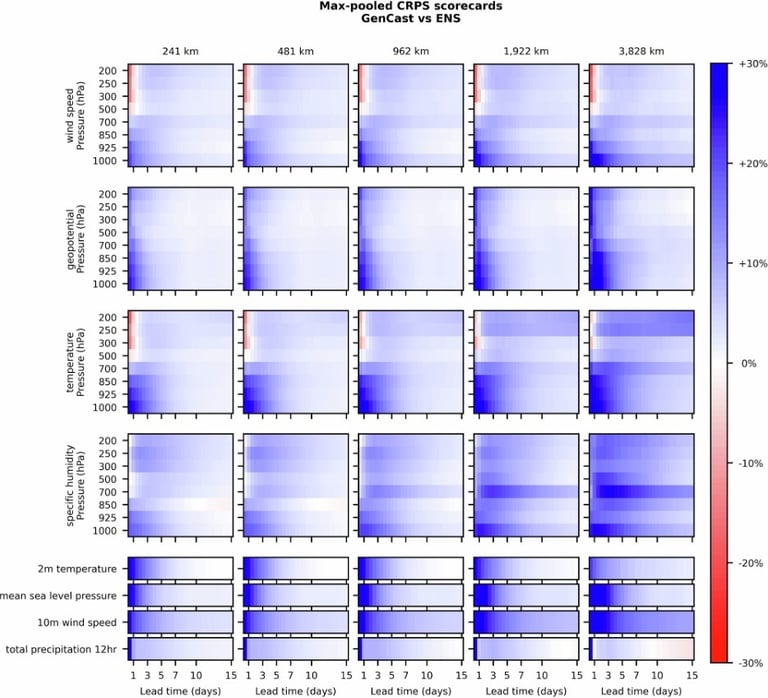DeepMind’s GenCast Is Beating ECMWF Globally; But Can You Trust It Locally for Energy, Agriculture, and Logistics?
GenCast may beat ECMWF on global weather benchmarks, but can energy traders, farmers, and logistics teams really trust its forecasts where it matters: at the asset, field, and route level?
11/24/20259 min read
Google DeepMind recently released a YouTube video showcasing their most advanced weather forecasting model.
Let’s dive deeper to understand it at a more detailed level.



So, in December 2024, Google DeepMind made waves in the meteorological community with GenCast, an AI-powered weather forecasting model that claimed to outperform the European Centre for Medium-Range Weather Forecasts (ECMWF) ensemble system; long considered the gold standard in global weather prediction. According to DeepMind's Nature publication, GenCast demonstrated superior accuracy on 97.2% of 1,320 evaluated forecast targets, with even more impressive results (99.8% accuracy advantage) at lead times beyond 36 hours. For an industry accustomed to incremental improvements measured in hours or days of forecast lead time, these numbers represent what researchers called "decades worth of improvements in one year". [1][2][3]
But hey, before energy traders rush to replace their ECMWF subscriptions, logistics managers overhaul their supply chain algorithms, or agricultural operators retool their precision farming systems, a critical question demands attention: Does this global performance translate to local accuracy where your business actually operates?
The Evaluation Methodology: What Google Actually Measured
Now, to understand the significance and limitations of DeepMind's claims, we must carefully examine how they evaluated GenCast's accuracy. This scrutiny reveals both impressive technical achievements and concerning gaps that matter immensely for industry applications.
Basically, DeepMind's evaluation was extensive by academic standards. They tested GenCast against ECMWF's ENS (Ensemble Prediction System) across 1,320 combinations of variables, forecast lead times, and atmospheric pressure levels. The primary metric was the Continuous Ranked Probability Score (CRPS), a sophisticated measure of probabilistic forecast skill that assesses how well forecast probability distributions match actual observations. [4]
Put simply, in easy terms, CRPS is a score where lower = better overall forecast quality
From there, the evaluation spanned multiple dimensions. GenCast generates 15-day forecasts at 0.25° latitude-longitude resolution (approximately 28 km × 28 km grid cells at the equator), producing predictions for more than 80 surface and atmospheric variables at 12-hour intervals. Both models were evaluated against ERA5 reanalysis data, ECMWF's own best-estimate reconstruction of past weather, using 2019 as the test year. [5]
On top of that, beyond CRPS, DeepMind employed an array of verification metrics including Root Mean Square Error (RMSE) of ensemble means, spread/skill ratios and rank histograms for calibration assessment, Brier skill scores for extreme event prediction, and Relative Economic Value (REV) curves that evaluate forecast utility across different cost/loss decision thresholds. For cyclone tracking, they applied the TempestExtremes tracker to evaluate position errors and track probability fields. [4]
Spatial Aggregation: Where the Global Story Begins
Here’s the thing: here's where energy traders, farmers, and logistics operators need to pay close attention. DeepMind's headline 97.2% accuracy claim is calculated by spatially averaging errors across the entire globe. Each of those 1,320 targets represents a global mean; temperature at 850 hPa averaged across all ~1 million grid points covering Earth's surface, wind speed at 10 meters similarly averaged worldwide, and so forth. [4]
Plus, while DeepMind did evaluate some spatially pooled metrics at scales ranging from 120 km to 3,828 km, and conducted regional wind power forecasting using 5,344 wind farm locations globally, their primary performance claims remain globally aggregated. The Nature paper provides virtually no breakdown of performance by individual countries, specific regions, or grid-cell-level accuracy variations, precisely the information that matters most for operational decision-making. [4]


The Critical Gap: Global Averages vs. Local Accuracy
So, let us understand with simple analogy:
“A model can be great on average worldwide but still be wrong in your city, like a clothing brand that fits ‘average’ people well but is terrible for your body type.”
Why Global Metrics Mislead Industry Users
Now, consider a simplified example: If GenCast predicts temperature with 2°C error in Northern Europe and 0.5°C error in the Sahara Desert, while ECMWF shows 1.5°C error in both regions, global averaging might show similar overall performance. But for a wind farm operator in Denmark or a grain trader in Germany, GenCast would actually perform worse than ECMWF in their specific region of interest; a fact completely obscured by global aggregation. [6]
This isn't merely academic pedantry. Independent research using the SAFE (Stratified Assessments of Forecasts over Earth) framework has revealed troubling disparities in AI weather model performance when disaggregated by geographic attributes. The SAFE analysis evaluated the same AI models (including GraphCast, GenCast's predecessor from the same DeepMind team) and found:
Performance varies dramatically by territory: The greatest absolute difference in temperature forecast RMSE across different countries reached 0.53 Kelvin at just 12-hour lead time, expanding to over 4.5 Kelvin at 10-day lead times [6]
Income-level disparities: At short lead times, models performed worst in low-income territories. However, by 48-hour lead time and beyond, every model showed worse accuracy in high-income regions than in low-income areas; a counterintuitive finding that highlights how model behavior changes with forecast horizon [6]
Regional biases persist: Models exhibit substantially higher errors when compared against ground-based weather station observations than against reanalysis data, with errors differing by a factor of approximately 2 for two-week ahead forecasts [7]
In short, the SAFE research concluded that "these disparities generally increase with lead time, particularly after three days" and that "AI weather prediction models exhibit biases in forecast performance based on geographic region, income, landcover, and lead time".
Industry Implications: Why Local Matters More Than Global
Energy Trading: The Million-Euro Grid Cell
"Straight up, if you’re an energy trader, the key question isn’t global accuracy; it’s how good the model is at your wind farms and market hubs."
For energy traders, weather forecast accuracy at the country and grid-cell level directly impacts profitability. European power markets operate on day-ahead and intraday timeframes where even 1% forecast error in renewable generation can trigger economic losses of several million euros annually for portfolios exceeding one gigawatt capacity. [8][9]
Wind and solar power forecasting requires hyper-local accuracy because:
Terrain complexity spoils accuracy: Forecast errors for individual wind farms can range from 7% to 19% for day-ahead predictions, with mountainous regions and coastlines showing significantly higher errors than flat terrain [8]
Spatial aggregation hides site-specific problems: While regional portfolio forecasts benefit from spatial smoothing effects, individual facility operators need site-level precision [8]
Intra-hour trading demands nowcasting: With 15-minute settlement periods in many European markets, GenCast's 12-hour time step resolution is fundamentally inadequate [9]
On top of that, independent analysis of AI weather models over the Indian subcontinent during monsoon season revealed that models "exhibit substantially higher errors when compared against ground-based weather station data" and "fail to predict extreme precipitation" at regional scales. For energy traders operating in tropical and subtropical markets, these regional failure modes could prove catastrophic, yet they're invisible in global performance metrics. [7]
Agriculture: Hyperlocal Weather for Precision Farming
"Honestly, if you’re a farmer or ag operator, the key question isn’t global accuracy; it’s how good the model is on your actual fields and microclimates."
Agricultural decision-making operates at field-level spatial scales, where weather variations over kilometers can determine irrigation schedules, pesticide application timing, harvest dates, and ultimately, profitability. [10]
Precision agriculture requires:
Sub-kilometer resolution: Leading agricultural weather services now provide forecasts with 90-meter to 1-kilometer precision, accounting for local topographic variations and elevation differences [11][10]
Hourly temporal resolution: Crop development models need hourly temperature and precipitation data, not 12-hour snapshots [12]
Extreme event accuracy: Hailstorms, frost events, and heavy rainfall predictions at the local level matter far more than global average temperature accuracy [10]
The catch is, GenCast's 28 km × 28 km grid cells (784 square kilometers per cell) cannot resolve the microclimate variations that agricultural operations depend on. A single GenCast grid cell might encompass dozens of farms experiencing markedly different weather conditions due to elevation, proximity to water bodies, or local wind patterns. [13]
Research on agricultural weather forecasting emphasizes that "data accuracy decreases as model resolution decreases" and that "hyperlocal weather tracking is crucial in agriculture". Studies combining local weather station data with global model outputs have achieved 34-36% error reduction compared to global models alone, improvements that could mean the difference between profit and crop failure.
Logistics and Supply Chain: Route-Level Forecasting
"If we’re real for a second, if you’re in logistics or supply chain, the key question isn’t global accuracy; it’s how good the model is along your routes and at your critical facilities."
Transportation and logistics operations require accurate forecasts along specific routes and at facility locations to optimize:
Delivery scheduling: Storm predictions affect trucking routes, maritime shipping, and air cargo
Warehouse operations: Temperature forecasts drive energy management and staffing decisions [14]
Just-in-time manufacturing: Weather-related delays propagate through supply chains, making location-specific accuracy critical
Thing is, AI weather models "miss major regional and high-frequency variability that could be critical to commercial operations" when operating at 25 km resolution with 6-hourly forecasts. During the May 2022 heatwave in Delhi, for instance, ECMWF's AI model underpredicted maximum temperatures by 5°C, a massive error for logistics planning that would be obscured in global performance averages.
The Resolution Reality: Why 28 km Isn't Enough
Here’s the rub: GenCast operates at 0.25° resolution (~28 km grid spacing), while ECMWF's current operational ENS system runs at 0.1° (~11 km since mid-2023). This 2.5-fold resolution gap matters enormously for industry applications: [13]
Topographic features: Mountain valleys, coastal effects, urban heat islands, and lake effects occur at scales smaller than 28 km
Convective precipitation: Thunderstorms, local heavy rainfall, and hail events require sub-10 km resolution to resolve
Renewable energy sites: Wind farms and solar installations need forecasts at their exact locations, not averaged over 784 square kilometers
Weather services serving energy markets now provide 1-2 km resolution forecasts updated hourly specifically because coarser resolution proves inadequate for operational decisions. Agricultural services have pushed to 90-250 meter resolution grids. GenCast's 28 km resolution, while impressive for a machine learning model, remains fundamentally too coarse for many critical industry applications. [9][12]
The Data Inequality Problem
A disturbing pattern emerges when examining where AI weather models perform best and worst. Research on global forecast inequality reveals that:
Temperature forecasts are more accurate in high-income countries [15]
Poorer countries have lower forecast accuracy and less weather observation infrastructure [15]
Observation density correlates with forecast skill: AI models trained on historical data perpetuate the observational biases embedded in that data
GenCast was trained on ERA5 reanalysis spanning 1979-2018. ERA5 itself reflects the geographic distribution of weather observations, denser in Europe and North America, sparser in Africa, South America, and parts of Asia. When AI models learn from this historically biased data, they risk encoding and amplifying existing inequalities in forecast quality. [15]
For multinational energy companies, agricultural commodity traders, or global logistics operations, this means forecast reliability may vary dramatically depending on where your assets are located; information completely absent from global performance metrics.
What Energy Traders, Farmers, and Logistics Managers Should Ask
Before adopting AI weather models for operational decisions, industry users should demand:
Stratified Performance Metrics
Accuracy broken down by country or grid cell, not global averages
Regional performance verification against local observations, not just reanalysis data
Temporal consistency: Does the model maintain accuracy across all seasons and weather regimes in your operating region?
Application-Specific Validation
For energy: Wind speed errors at turbine hub height (80-120 meters), solar irradiance accuracy at plant locations, temperature forecast skill for demand prediction at utility service territories
For agriculture: Precipitation timing at field scale, extreme temperature prediction for critical crop stages, frost and heatwave forecasting at farm locations
For logistics: Route-specific precipitation and wind forecasts, facility-level temperature predictions, severe weather event detection with minimal false alarms
Resolution and Update Frequency Requirements
Spatial resolution appropriate to decision-making scale (sub-10 km for most applications)
Temporal resolution matching operational cycles (hourly updates for energy trading, sub-hourly for severe weather)
Lead time optimization: Which model performs best at the specific forecast horizon you need (6 hours? 24 hours? 7 days?)
The Verdict: Global Excellence Doesn't Guarantee Local Reliability
Bottom line, Google DeepMind's GenCast represents a genuine breakthrough in weather forecasting, demonstrating that AI models can match or exceed physics-based systems on global aggregate metrics while requiring 1000-fold less computational energy. The 97.2% accuracy claim is real, rigorously verified, and scientifically significant.
However, for energy traders positioning megawatt-scale portfolios, farmers timing planting and harvest operations, or logistics managers routing shipments through storm systems, global averages provide dangerously incomplete information. The same model showing 97% global accuracy might perform brilliantly in Western Europe while underperforming dramatically in Southeast Asia, Sub-Saharan Africa, or even specific grid cells within otherwise well-forecasted regions.
ECMWF's operational forecasts, despite potentially showing lower global aggregate scores, maintain regional expertise, higher spatial resolution, and validation infrastructure built over 50 years. Many national meteorological services continue to add localized bias correction, downscaling, and ensemble post-processing specifically because global models, whether AI or physics-based, require regional calibration for operational use.
The path forward isn't choosing between AI and traditional forecasting, but demanding transparency about where and when each approach excels. Until AI weather model providers publish stratified performance metrics at regional, country, and grid-cell levels, industry users should maintain healthy skepticism about whether global performance translates to local reliability in their specific operating environment.
For now, the prudent approach combines sources: use AI models for computational efficiency and rapid scenario generation, validate against physics-based forecasts for critical decisions, and always verify against local observations in your area of operations. The weather forecast revolution is indeed here but the devil, as always, remains in the local details that global averages obscure.
REFERENCES


